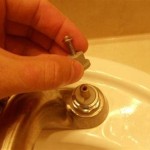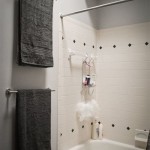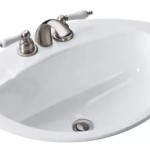Bathroom Sink and Countertop In One: A Comprehensive Overview
Integrating the bathroom sink and countertop into a single unit offers a sleek and functional design solution for modern bathrooms. This configuration, often referred to as an integrated sink and countertop, presents a visually seamless surface, eliminating gaps and crevices that can harbor dirt and bacteria. Integrated units are available in a wide variety of materials, styles, and sizes, making them a versatile option for diverse bathroom designs, from minimalist and modern to more traditional aesthetics. Understanding the benefits, construction methods, and material options is crucial for selecting the optimal integrated sink and countertop for a specific bathroom project.
The core appeal of an integrated sink and countertop lies in its clean lines and ease of maintenance. The absence of a seam between the sink and the countertop surface prevents water from seeping into the joint, mitigating the risk of mildew growth and simplifying cleaning routines. This is a significant advantage over traditional drop-in or undermount sink installations, which often require regular caulking to maintain a watertight seal. Furthermore, the unified aesthetic contributes to a sense of spaciousness and visual harmony, particularly valuable in smaller bathrooms where maximizing the perception of space is paramount.
Integrated sink and countertop units are manufactured using various techniques, each impacting the final product's durability, appearance, and cost. These manufacturing processes range from molding and casting to fabrication from solid surface materials. The choice of manufacturing technique often correlates with the specific material used in the construction of the integrated unit.
Advantages of Integrated Sink and Countertop Designs
Integrated sink and countertop configurations offer several distinct advantages over traditional separate sink and countertop installations. These benefits span aesthetics, hygiene, and overall functionality, making them a compelling choice for many bathroom renovation or new construction projects.
Firstly, the seamless design offers a visually appealing aesthetic. The continuous surface creates a sense of flow and unity, contributing to a more refined and modern bathroom environment. This uninterrupted appearance is particularly well-suited for minimalist and contemporary designs, where clean lines and simplicity are highly valued. The absence of visible seams or joints enhances the overall sophisticated look of the bathroom.
Secondly, hygiene is significantly improved with an integrated unit. The lack of seams eliminates potential breeding grounds for mold, mildew, and bacteria. Traditional sink installations often require ongoing maintenance to seal and reseal the joints between the sink and the countertop, whereas an integrated unit removes this maintenance burden. The smooth, non-porous surface of many integrated units also contributes to easier cleaning and disinfection, further enhancing hygiene.
Finally, integrated units can offer enhanced durability over time. When properly installed and maintained, an integrated sink and countertop can withstand daily use and resist damage from water and cleaning agents. Depending on the material, the unit may be resistant to staining, scratching, and chipping, ensuring a long lifespan and reducing the need for frequent replacement. This long-term durability can translate to cost savings over the lifespan of the bathroom.
Common Materials Used in Integrated Sink and Countertop Construction
The selection of material for an integrated sink and countertop is a critical decision, influencing both the aesthetic appeal and the practical performance of the unit. Different materials offer varying levels of durability, stain resistance, heat resistance, and aesthetic characteristics. Common materials include acrylic, solid surface, cultured marble, and vitreous china, each with its own set of advantages and disadvantages.
Acrylic is a popular choice for integrated sinks due to its affordability and versatility. Acrylic is a lightweight material that can be molded into various shapes and sizes, allowing for a wide range of design options. It is also relatively resistant to scratching and staining, and any minor scratches can often be buffed out. However, acrylic is not as heat resistant as some other materials and can be susceptible to damage from harsh chemicals.
Solid surface materials, such as Corian and Swanstone, offer a higher level of durability and design flexibility than acrylic. These materials are non-porous, making them highly resistant to staining and bacteria growth. Solid surface countertops can also be seamlessly joined, allowing for custom designs and larger installations without visible seams. They are also more heat resistant than acrylic, though they are still susceptible to damage from extreme heat. Solid surface materials are generally more expensive than acrylic but offer a longer lifespan and a more luxurious appearance.
Cultured marble is a composite material made from marble dust and resin. It is a cost-effective alternative to natural marble, offering a similar aesthetic at a lower price point. Cultured marble is available in a wide range of colors and patterns, and it is relatively easy to clean and maintain. However, it is more susceptible to scratching and staining than solid surface materials, and it can be damaged by abrasive cleaners. While initially glossy, the finish can dull over time.
Vitreous china is a traditional material for bathroom sinks, known for its durability and resistance to staining. When used in an integrated sink and countertop, vitreous china provides a classic and elegant look. It is highly resistant to heat and most chemicals, making it a practical choice for high-use bathrooms. However, vitreous china can be brittle and prone to chipping if subjected to impact. Integrated vitreous china sinks and countertops are less common than other material options, but they offer a timeless aesthetic and excellent performance.
Installation Considerations for Integrated Sink and Countertop Units
Proper installation is crucial for ensuring the long-term performance and aesthetic appeal of an integrated sink and countertop. Improper installation can lead to water leaks, structural instability, and premature wear and tear. Careful planning and adherence to manufacturer's instructions are essential for a successful installation.
Before installation, it is important to ensure that the bathroom cabinetry or supporting structure is level and sturdy. The integrated sink and countertop unit will rely on this support to maintain its integrity and prevent stress fractures or warping. Any discrepancies in the level of the cabinetry should be addressed before proceeding with the installation.
The plumbing connections for the sink must be carefully aligned and properly sealed to prevent water leaks. The drainpipe and water supply lines should be positioned correctly to accommodate the sink's drain and faucet. It is important to use appropriate plumbing fittings and sealants to create a watertight connection. Professional plumbing assistance may be necessary to ensure that these connections are made correctly.
Securing the integrated unit to the cabinetry is essential for stability. Depending on the design of the unit and the supporting structure, different methods can be used to secure the unit in place. This may involve using adhesive, screws, or a combination of both. It is important to follow the manufacturer's instructions for securing the unit to ensure that it is properly supported and will not shift or move over time. The attachment must also be able to support the weight of the unit when filled with water.
Finally, after installation, it is important to thoroughly inspect the unit for any signs of leaks or damage. Check the plumbing connections for leaks and ensure that the sink drains properly. Also, inspect the countertop surface for any scratches, chips, or other imperfections. Addressing any issues promptly will help to prevent further damage and ensure the long-term performance of the integrated sink and countertop.
In summary, the integrated sink and countertop provides a contemporary and practical solution for bathroom design, offering a seamless appearance, enhanced hygiene, and potential durability benefits. The choice of material significantly influences the overall performance and aesthetic of the unit, and careful installation is essential for long-term functionality. By considering these factors, one can select and install an integrated sink and countertop that meets the specific needs and aesthetic preferences of a given bathroom project.

Farmington Blue 37 Vanity Combo Sink Countertop All In One

Home Decorators Collection Sassy 72 In Single Sink White Bath Vanity With Carrara Marble Top Assembled 72w

One Piece Bathroom Sink And Countertop From China Stonecontact Com

Vanity Countertop Diffe Options You Can Choose From

Farmington White 31 Vanity Combo Sink Countertop All In One

Diy Wood Countertop Made With One Board Small Bathroom Makeover On A Budget Part 2

Ariel Hepburn 30 Inch Single Rectangle Sink Bathroom Vanity With Carrara White Quartz Countertop 1 5 Edge In Oak

New Fresh Interior Design Ideas For Your Home

Zeafive 42 In W X 22 D Solid Surface Stone Countertop One Piece Rectangular Left Single Sink Vanity Top White With Basin Zbt T 42l The Home Depot

One Piece Bathroom Sink And Countertop From China Stonecontact Com
Related Posts







